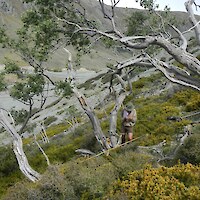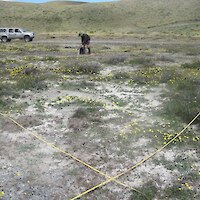The Tekapo military training facility is located approximately 6 km west of the Tekapo Township. It consists of two discrete areas: the Tekapo Military Training Area (TMTA, c.8,000 ha) and the Tekapo Military Camp (TMC, c.352 ha). The New Zealand Defence Force (NZDF) is committed to managing land that it administers in a way that is consistent with the “sustainable management” purpose of the Resource Management Act (1991) and the Ministry for the Environment’s Sustainable Land Management Strategy.
In 2011, Wildlands was commissioned by NZDF to monitor grassland habitats within the TMTA. In December 2011 and February 2012, Wildlands undertook a detailed field survey of indigenous shrublands and wetlands within the TMTA. In December 2012 and December 2013, Wildlands undertook an ecological assessment of vegetation and invertebrates in the Mt Stevenson Block, a recent addition to the TMTA.
Permanent plots were established in grassland, shrubland, wetland, riverbed, fellfield, and boulderfield sites.
A total of 319 vascular plant species were recorded in the TMTA, with 43 of these being nationally ‘Threatened’, ‘At Risk’, and ‘Data Deficient’ taxa, including Leonohebe cupressoides and Lepidium solandri (both Threatened–Nationally Endangered), and Amphibromus fluitans , Carex rubicunda, Isolepis basilaris, Kirkianella novae-zelandiae, Myosotis brevis, Pachycladon cheesemanii, and Senecio dunedinensis (all Threatened–Nationally Vulnerable). Also present are several plant species that are regionally uncommon (Acaena tesca, wire rush (Empodisma minus), bog pine (Halocarpus bidwillii), and Rostkovia magellanica) or locally uncommon (Olearia bullata and Hypolepis rufoglandulosis). This is a very high concentration of uncommon plant species.
The TMTA was found to contain 11 historically rare ecosystems, seven of which are classified as Threatened. These historically rare ecosystems collectively cover a large part of the TMTA, and provide habitat for most of the Threatened and At Risk species recorded during the survey.
Wildlands staff also identified a nationally outstanding assemblage of wetlands and riverbed vegetation associations, excellent representation of Wolds-age glacial landforms, representative tussock grassland associations, and species-rich shrublands on screes and in some riparian sites. The upper part of Fork Stream catchment and its riverbed and outwash plains is of national importance given the widespread loss and modification of braided river systems in New Zealand.
A total of 248 invertebrate taxa have been recorded in the TMTA, including 187 Lepidoptera taxa characterised by notably high species richness of crambid, noctuid, and geometrid moths. Eight Threatened, At Risk, or Data Deficient invertebrate taxa were recorded, including the robust grasshopper Brachaspis robustus (Threatened–Nationally Endangered) and the moths Graphania tetrachroa and Pasiphila sp. ‘Olearia’ (both Threatened–Nationally Vulnerable).





























